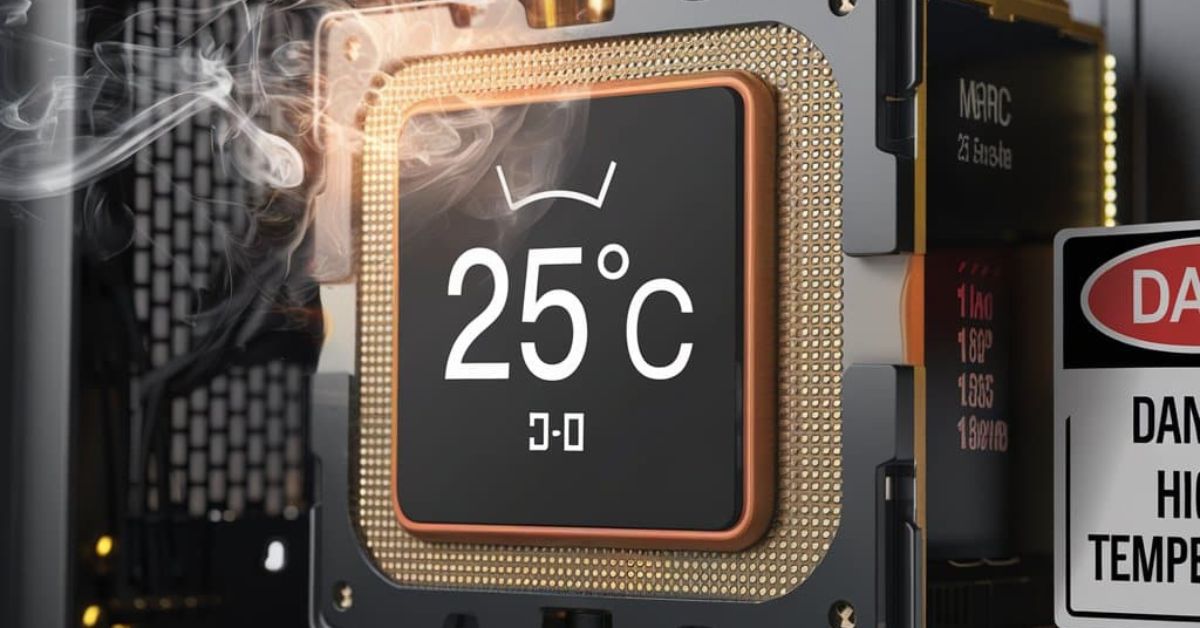Cpu Stuck At Displaying 25c – Discover The Causes And Fixes!
My CPU was stuck at 25°C, no matter what I did. I restarted it several times, but it didn’t change. Turns out, the temperature sensor was broken.
If your CPU is stuck at 25°C, it could be a broken temperature sensor. Try restarting your computer to see if that helps. If not, you might need to replace the sensor or get help from a technician.
Stay tuned as we discuss why your CPU might be stuck at 25°C and how to fix it. We’ve got some helpful tips coming your way!
What is the normal CPU temperature range, and what does it mean if your CPU is stuck at 25°C?
The normal CPU temperature typically ranges from 30°C to 40°C when idle and can go up to 60°C to 85°C under heavy use, such as gaming, video editing, or running demanding software. If your CPU is stuck at 25°C, it could indicate that the system is in an idle state, with minimal activity, or it could suggest a deeper issue.
A temperature stuck at 25°C even under load might be caused by a malfunctioning temperature sensor, poor thermal paste application, inadequate cooling, or airflow issues. To fix this, you can check the cooling fans, ensure proper ventilation, and monitor the system’s internal temperature sensors for any discrepancies.
Why Is My CPU Stuck at 25°C?

There are a few reasons why this might happen, from hardware problems to software issues. Let’s go through some of the most common causes:
Hardware Issues
1. Faulty Temperature Sensors:
The sensor that reads the temperature could be broken. If it is, it might always show 25°C, even though the CPU temperature is actually higher or lower.
2. Thermal Paste Degradation or Incorrect Application:
Thermal paste helps the CPU stay cool by transferring heat to the heatsink. If the paste gets old or isn’t applied properly, it can make the CPU overheat or cause incorrect temperature readings.
3. Cooling System Failure:
Your cooling system (like the CPU fan or heatsink) helps prevent overheating. If something’s wrong with it—like a fan not working or dust blocking airflow—it might stop cooling the CPU properly.
4. Power Supply Problems:
A weak or broken power supply could cause incorrect temperature readings. If the power supply isn’t giving enough power, the sensor might not read temperatures correctly.
Software and BIOS Issues
1. Outdated BIOS or Misconfigured Settings:
Your BIOS (basic system software) might be outdated. If it is, it might show wrong temperatures. Sometimes, settings in the BIOS can be wrong, causing issues with temperature readings.
2. Issues with Monitoring Software:
The software you use to check your CPU’s temperature could be giving false readings because of bugs or errors. It’s a good idea to check with more than one tool to make sure the data is correct.
How to Diagnose a CPU Stuck at 25°C?
Step 1: Check the Monitoring Software
Start by checking the temperature with different software. Sometimes, the tool you’re using can be wrong. Try tools like HWMonitor or Core Temp to get a second opinion.
Step 2: Inspect Hardware Components
Check your CPU cooling system. Make sure the fans are spinning, and that the heatsink is clean and working. Also, check the thermal paste between the CPU and heatsink—if it’s old or dry, it needs to be replaced.
Step 3: Update BIOS and Drivers
An old BIOS version could cause temperature errors. Go to your motherboard maker’s website to see if there’s a newer version of BIOS available. Also, make sure your motherboard and chipset drivers are up to date.
Step 4: Test the Power Supply
Your power supply should be stable. If it’s not, it can cause your CPU temperature to be stuck at 25°C. You can use a multimeter or software to check if the power supply is working well.
Step 5: Reseat the CPU
If you still have issues, you might need to reseat the CPU. This means taking it out and putting it back in again. Be sure to apply fresh thermal paste before reinstalling it.
What are 7 proven solutions for fixing the issue of a CPU stuck at 25°C?

Update BIOS and Software:
Start by updating your BIOS and reinstalling temperature monitoring software. This ensures you’re getting accurate readings and the latest fixes for any temperature-related bugs.
Reapply Thermal Paste:
If you suspect that thermal paste is the issue, clean off the old paste and apply new thermal paste. This improves heat transfer between the CPU and heatsink, helping to keep the CPU cool.
Improve Your Cooling System:
Check if your cooling system is working properly. Clean any dust from the fans and heatsinks, and replace faulty components if needed. Upgrading to a more efficient cooling system can also improve overall performance.
Replace Faulty Components:
If your temperature sensor or power supply is malfunctioning, it can affect CPU temperature readings. Replace these faulty components with ones that are compatible with your CPU and motherboard.
Re-seat the CPU:
Remove and carefully reinstall your CPU to ensure it’s seated correctly. When doing this, always apply fresh thermal paste to maintain optimal heat dissipation.
Use High-Quality Monitoring Tools:
For more accurate temperature readings, use reliable software like AIDA64 or SpeedFan. These tools provide detailed information about your system’s temperature and health.
Regular System Maintenance:
Keep your computer clean by regularly removing dust from fans and heatsinks. Ensure that your case has good airflow to prevent heat buildup and improve cooling efficiency.
Can a CPU Work Fine at 25°C?

Yes, a CPU can work just fine at 25°C, especially when it’s not doing anything too demanding. When your computer is idle or doing light tasks, temperatures around 25°C are completely normal.
However, if the temperature stays stuck at 25°C even during heavy use, it could mean there’s an issue with the temperature sensor, cooling system, or thermal paste. In such cases, you should check the system to make sure everything is working properly.
How can you monitor and improve your CPU cooling to prevent temperature issues?
To monitor and improve your CPU cooling, regularly check the temperature using reliable tools like SpeedFan or HWMonitor. This helps you catch any problems early. Keep your cooling system clean by removing dust from fans and heatsinks.
If your CPU is getting too hot, consider upgrading to a better cooler, especially if you’re doing heavy tasks like gaming or video editing. A good cooling system can keep your CPU running smoothly and prevent overheating.
When is it time to get professional help for CPU temperature or cooling problems?
You should get professional help for CPU temperature or cooling problems if basic fixes, like cleaning the fans, applying new thermal paste, or improving airflow, don’t solve the issue.
If your CPU keeps overheating, temperature readings are inaccurate, or the cooling system is not working properly, it could be due to a damaged cooling fan, broken sensor, or issues with the thermal paste.
A technician can thoroughly check your system, fix any faulty components, and ensure everything is working as it should to prevent any long-term damage to your CPU.
FAQs:
1. How can I troubleshoot a CPU stuck at 25°C?
If your CPU temperature is stuck at 25°C, it might be due to a faulty temperature sensor or cooling system. To fix this, try updating your BIOS, cleaning the cooling system, and reapplying thermal paste.
2. Can I run my PC with the CPU stuck at 25°C?
It’s safe to run your computer if the temperature is stuck at 25°C, but it might indicate a problem. Try fixing it to avoid future issues.
3. Should I replace my CPU if it’s showing 25°C?
No, it’s unlikely that the CPU itself is the problem. The issue is probably with the sensor or cooling system.
4. What is the ideal idle temperature for a CPU?
An idle CPU should normally be between 30°C and 40°C. If it’s lower than that, it’s likely due to a sensor problem or your cooling system working too well.
5. Can BIOS updates help with CPU temperature reading issues?
Yes, updating your BIOS can fix problems with hardware monitoring and make your system work better with new parts, which might correct wrong temperature readings.
Conclusion:
A CPU stuck at 25°C isn’t always a serious problem, but it’s good to check and fix it if needed. By following these steps, you can keep your CPU working well and avoid future issues. Regular maintenance and checking the temperature can help prevent this from happening again.
Read More: cpu temp limit gg helper







